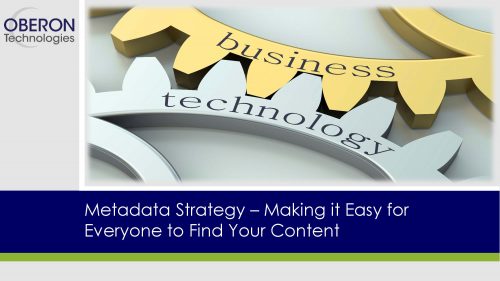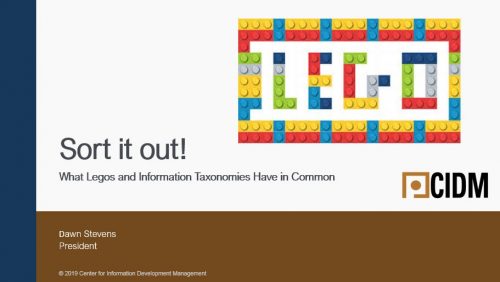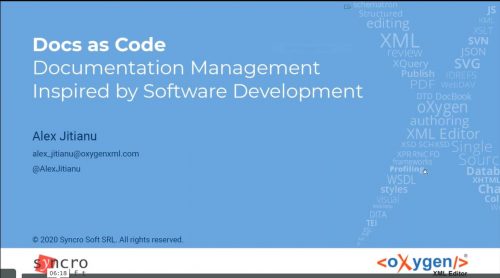-
September 17, 2019 When your users can’t easily find your information online, they may turn to the competition. When your writers can’t find the content they need, they will recreate it. And, when your organization doesn’t have a common strategy to identifying information across the enterprise you are wasting valuable resources as they search to find needed information. Whether in document properties, a keyword spreadsheet or within your content management systems, metadata is a key to findability. Learn how a metadata strategy adopted by all the content creators can make it easier for everyone inside and outside your organization to find the information they need. Presented by: Todd Burdin is a senior solution architect and strategic business consultant with 25+ years of software development and business consulting expertise, encompassing the entire content development lifecycle. He has extensive experience delivering innovative enterprise solutions for content management, structured authoring, and publishing to a diverse set of industries, including equipment manufacturers, pharmaceuticals, legal mediations, hospitals, and financials. Todd has worked at Oberon Technologies for 6+ years. Previous employers include PTC, Arbortext, Entrusted Solutions, and First Consulting Group.
-
October 9, 2019 Delivering a cCMS solution on time and on budget is critical, but it’s important to recognize that the cCMS is only one part of a successful content lifecycle strategy. Making sure your content can be leveraged across the enterprise and your system will be able to support future initiatives requires a comprehensive and proven plan. Having led hundreds of successful content solution implementations, Oberon understands the differences in the tools, processes and environments that must be considered. While each cCMS implementation plan may be unique, shaped by the specific needs of a given company, there are many common steps to success that everyone should follow. Whether you are looking to adopt cCMS for the first time or you’ve been using one for years, there are ways to ensure your system is optimized for success. Attend this webinar and find out what your plan should include. Presented by: Vi Kellersohn is the Chief Marketing Officer of Oberon Technologies. Vi leads the marketing efforts, manages strategic partnerships and supports key client projects. For over 20 years Vi has managed and executed all aspects of marketing for B2B technology organizations working in partnership with sales management to build awareness for value opportunities across the content lifecycle. Vi enjoys spending time with her extended family and golfing with her husband and two sons.
-
August 28, 2019 Looking for a single piece of content on a web site is often compared to digging in a giant bucket of LEGOs for a single unique piece – an often frustrating and futile endeavor. If those LEGOs are sorted by certain distinguishing attributes, such as color and size, the odds of finding a particular piece increase dramatically. As a result, companies often take a “LEGO-block” approach to their information taxonomies. However, the sorting of LEGO blocks is child’s play, compared to the intricacies of sorting technical content – the distinctions are not always as visible as color or size, and attributes that are that obvious may not be very useful in a search. Nevertheless, there are lessons we can learn from the “LEGO-block” approach. In this session, Dawn draws parallels between sorting LEGOs and sorting technical content, and provides suggestions for going deeper when the Lego model falls short. Presented by: Dawn Stevens is the President, and owner of Comtech Services and the Director of the Center for Information-Development Management. With over 25 years of experience, including 15 years at Comtech, Dawn has practical experience in virtually every role within a documentation and training department, including project management, instructional design, writing, editing, and multimedia programming. With both engineering and technical communication degrees, Dawn combines a solid technical foundation with strong writing and design skills to identify and remove the challenges her clients face in producing usable, technical information and training.
-
September 19, 2019 No matter where and how you author your content today – Word, InDesign, XHTML, Markdown, DITA, FrameMaker, and more – offering an immersive experience to your customers is the need of the hour. If you are still publishing your content as static PDFs only, you are depriving them of a rich and rewarding consumption experience full of unique possibilities. With the right digital experience solution, you can plug-in data insights to design, manage and deliver consistent, personalized and targeted content for every single customer. Join us in this webinar to see how an integrated solution can help you:
- Move from publishing static PDFs only to delivering immersive, fluid experiences throughout the customer journey
- Leverage next-generation capabilities like personalization, analytics, and targeting
- Still be able to publish to other popular formats at will – HTML5, Mobile Apps, EPUB, KINDLE and more
-
December 4, 2019 In this webinar, Bluestream will show how advanced integration with oXygen Author and Editor throughout the content lifecycle can greatly help everyone involved in creating content. From content creation, review, branching and merging, release management and delivery via Oxygen Chemistry and Oxygen WebHelp Bluestream will show what the future is bringing. Presented by: Nenad Furtula a Partner, and VP of Sales and Marketing at Bluestream Database Software. Nenad has been working with XML and bringing XML related products to market for over 15 years. Currently his primary professional interest lies in building and socializing a DITA-enabled component content management system called XDocs. Nenad holds a BBA from Capilano University and MSc (Computer Science) from Dalhousie University.
-
February 5, 2020 If you are implementing a large-scale infrastructure project such as a cCMS implementation or migration to DITA at your organization, then you know about predictable costs such as purchasing hardware, licensing software, and training writers. Predictable expenses are easy to manage and plan for as you know when they will be due, and at least approximately how much they are going to cost. There are, however, other potential costs that may be unknown, either because your requirements have iterated since the original project scope was defined or you have uncovered something unexpected in your environment. These unpredictable expenses can add risk to the overall project timeline or impact the actual cost. They may be challenging to fit into your existing plan or require additional planning. In this webinar, Sabine Ocker will discuss some top hidden costs and provide insights on how to identify, plan for, and mitigate the impact of common examples such as changes to project scope, lack of appropriate standards, and content conversions. Presented by: Sabine Ocker has 20 plus years’ experience helping companies solve their interesting business problems. Solutions have included DITA migrations, content conversions, new tools or CMS, information modeling, content strategy, multi-channel publishing, and taxonomy development.
-
February 12, 2020 Products are sold into markets that cross both country and language boundaries, so product documentation must be localized. Localizing documentation is made easier with DITA, a capable Component Content Management System (CCMS), and a Translation Management System (TMS). Even with these systems in place, you must always consider best practices and pitfalls. Jim will begin with an overview of the localization process, of how content flows across systems and organizations. In this context, we will discuss techniques and also wins and pitfalls in automating and streamlining the localization process. In this session, attendees will learn:
- About the localization process-what are the various roles and how does content flow
- About use cases and constraints-what is incremental localization and what is the relationship of localization to the product release lifecycle
- About release management and localization-what role can branching play in localization
- About localization tools-how do CCMS, TMS, and LSP relate in the localization process
- About recent developments in automation-how can the localization process be accelerated through automation and what are the wins and pitfalls of automation
-
March 4, 2020 Technical documentation is rarely created by lone writers, so there is a constant need for collaboration. Collaboration can be with other writers or with people with other roles, usually referred to as subject matter experts, who may be part of your organization or external experts. In order to be successful, the collaboration needs to be enabled by integrating it as part of the usual processes or workflows each user performs. In this presentation, we will explore a few collaboration scenarios that show how to implement continuous improvement loops for published documentation, how to integrate documentation as part of the product development workflow, and how immediate collaboration can take place. Presented by: George Bina is one of the founders of Syncro Soft SRL, the company that develops oXygen XML suite of XML editing, authoring, development, publishing and collaboration tools. He has more than 20 years of experience in working with XML and related technologies, bringing many innovative ideas to reality and contributing to XML-related open-source projects. He presented at many XML, DITA, and technical communication conferences, giving passionate presentations and challenging the technological status quo, trying to get the audience to think outside the box, and re-imagine the future.
-
April 1, 2020 Implementing DITA with a small team of technical writers does not have to be expensive or difficult to set up. We'll go through the steps of implementing a DITA solution using GitHub for storage and workflow and Oxygen XML Editor for editing. We'll also look into how you can automate publishing and receive feedback from your end users. As a practical example we'll look into how editing, collaboration and publishing on the Oxygen XML Blog works. Presented by: Radu Coravu started working more than 10 years ago as a software developer for Syncro Soft SRL, the manufacturer of the popular oXygen XML Editor. During the last years, his main focus has been in the development of the visual XML Author editing environment and the specific-DITA support provided by oXygen. He provides support for complex integrations and helps steer the product in the right direction, all this with some development on the side.
-
December 16, 2020 A step by step guide to getting started with Schematron and Schematron Quick Fixes. Schematron and Schematron QuickFix (SQF) languages can be used to improve efficiency and quality when editing DITA documents. You can define actions that will add complex structure in your documents, or make modifications in multiple places or actions that will convert a structure into another. These changes are made by keeping the document structure valid and conforming to your project specification and will help the content writer add content more easily and without making mistakes. Join us to see:
- How to create business rules with Schematron
- How Schematron rules are applied
- How to apply specific Schematron rules on all DITA files
- How to develop Schematron Quick Fixes to make it very easy to solve the reported problems
-
September 16, 2020 Tools and techniques used in software development can also be applied for documentation management:
- Storage and issue management using GitHub
- Automated quality checks and continuous publishing using Netlify
- Editing and collaboration support
- Release strategies
-
April 8, 2020 Technical Communication is in constant change: Requirements and expectations from both authors and consumers of technical content have changed dramatically over the last decade. The rise in digital experience innovation creates new customer expectations and demands. And enterprises around the world are exploring new ways to create new Content Interaction Experiences for their customers. In this presentation, Stefan Gentz will give insights from the Adobe Technical Communication Worldwide Survey 2019/2020. TechComm professionals from 60 countries participated in the survey. He will discuss the driving factors for enterprises around the world when it comes to technical communication. Why do companies choose to work with structured content, and why do they go for a CCMS? How do they deliver their content today – and how will they provide content tomorrow? KEY TAKEAWAYS
- Understand the key factors that are driving companies to move to structured content
- Understand which technologies companies use to author and deliver content today
- Know which are the “hottest” content delivery channels in the future to provide technical content to customers












